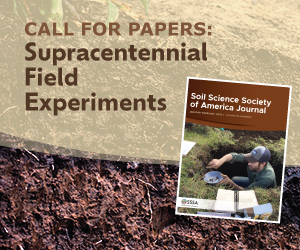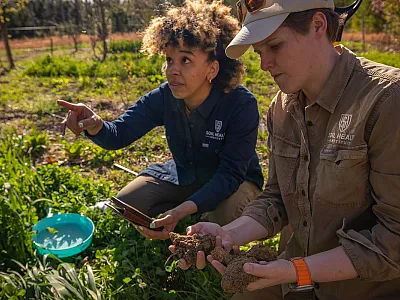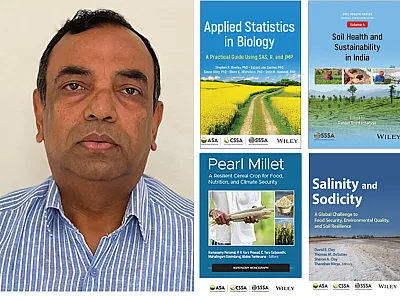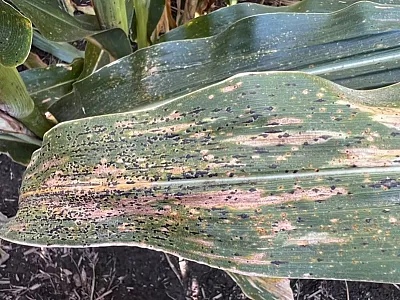Job Hunt: Landing Your First Position After Graduate School

For many students, getting the degree and walking in that graduate ceremony can often seem like the end goal during graduate school. We spend many years optimizing experiments and writing papers that it can be easy to forget that there is a world of opportunity outside our educational experience. When balancing the responsibilities of being a student, it can be difficult to anticipate what comes next and how to prepare. While determining the future career choice and managing networking strategies can be stressful and overwhelming, we are here to guide you through this process.
What Path Should I Take?
One of the first things to decide is the classic question: “What do I want to do when I grow up?” Within the agronomic, crop, and soil sciences, the possibilities truly seem endless when it comes to career paths. Below, we discuss some general types of careers you may find your dream role in.
Academia
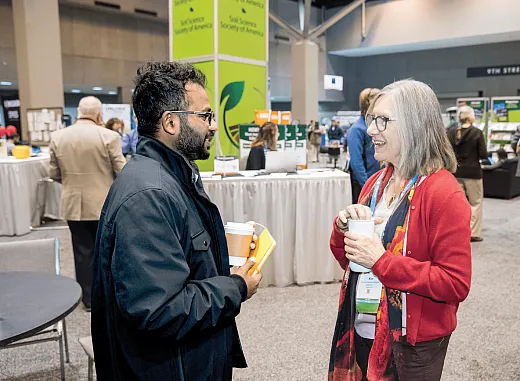
It is not uncommon to start an academic career as a postdoctoral researcher immediately after finishing a Ph.D. Conferences and seminars are good places to find potential professors and employers with which to do a postdoc. Try to find potential principal investigators (PIs) during conferences or seminars, request a meeting with them, and if possible, give a short presentation about your work and interests. Personal meetings provide better opportunities to show your work and interests and make future communications easier. You can also evaluate if the lab is the right fit for you and if the PI is cooperative and willing to support your future projects, including finding funding opportunities and writing grants.
Professorship positions typically have three components—research, teaching, and extension. Though more rare, some may be referred to as a three‐way split where the job has responsibilities in all three areas. However, more commonly, positions are a two‐way split with a larger percentage in one than another. As an example, some universities may have a tenured position that is 80% research and 20% extension or 55% research and 45% teaching.
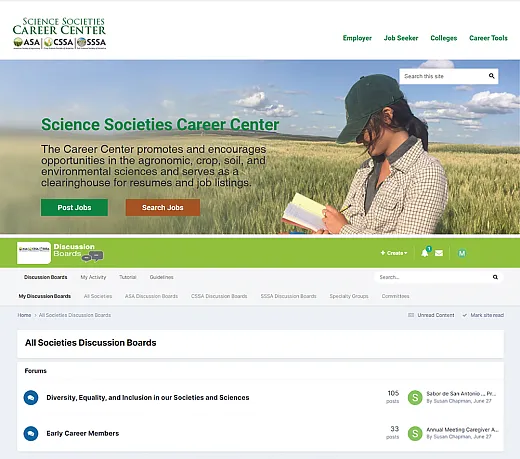
These positions are tenure‐track, meaning that assistant professorships (faculty positions) are evaluated over the first few years after appointment. Applying for tenure involves preparing a tenure package that provides detailed evidence of exemplary performance in all aspects of the position. As an assistant professor, there will be more research autonomy, and the faculty member will focus on crafting their own research line. Therefore, it will be necessary for the faculty to secure funding for research proposals as well as for hiring researchers such as Ph.D. and master’s students. This will enable the projects to be larger and involve more people.
There are several ways to find academic position announcements through different job hunt portals like LinkedIn. You can also find the positions on discussion boards (agronomy.org/discussion‐boards/) and the Career Center site (careerplacement.org) run by ASA, CSSA, and SSSA.
Government
Within government jobs, subject areas or positions often fall into the following categories: Agricultural Engineering, Agronomy, Animal Science, Biochemistry, Bioinformatics, Biology, Chemistry, Entomology, Food Science Genetics, Human Nutrition, Hydrology, Immunology, Microbiology, Molecular Biology, Physical Science, Plant Science, Soil Science, Veterinary Science, and Virology (ars.usda.gov/careers/careers‐in‐ars/). Within the USDA‐ARS specifically, there is a Postdoctoral Research Associate Program that offers recent Ph.D. graduates (with no more than three years of prior postdoctoral experience) the chance to conduct essential basic research alongside leading scientists. This program provides short‐term, salaried positions on specific projects, offering advanced training and experience. Research associates, hired at the GS‐11 or GS‐12 levels, must have completed their Ph.D. before employment. They receive the same vacation and sick leave as other federal employees, and those with appointments longer than one year are eligible for health and life insurance benefits. Creating an account on the USAJOBS website and setting email alerts for jobs you may be interested in could keep you from losing out on an opportunity.
Industry
Within industry, there are many opportunities in the U.S. and abroad to conduct science. Many partners and sponsors of ASA, CSSA, and SSSA events, including Bayer and Corteva, have a range of opportunities across basic and applied research and regulatory divisions. You can find the vacancies on different job hunt portals like LinkedIn, Indeed, ZipRecruiter, and company websites. Connecting with professionals in your field through conferences, seminars, and workshops can help in finding out about roles before they are posted and establishing your network within industry companies. Participating in summer internships or co‐ops with companies of interest can be invaluable for learning about whether industry is a good fit for you and making connections to help land a position in years to come.
Science Policy
A perhaps lesser‐known, yet incredibly important, career opportunity for scientists is to go into science policy and communication. Examples of such positions include scientific consulting for private clients, science corresponding for various networks, lobbying for science funding and policies, freelance editing and content reviewing, and more. Not sure if you want to make a full career in science policy but want to get your feet wet? There are many science policy opportunities for postgraduate students including the American Association for the Advancement of Science (AAAS) Science & Technology Policy Fellowship (https://bit.ly/4bv2EFB) and the National Academies Science Policy Fellowship (https://bit.ly/3zxw4pt).
Tailoring your resume, writing targeted cover letters, and preparing for specific types of interviews will be more straightforward when you have narrowed down your desired career field. This clarity will also help you in identifying and reaching out to the right people in your network, further easing the transition from graduate school to your desired career. Once you have decided on the career path you want to follow, starting the application process will become easier.
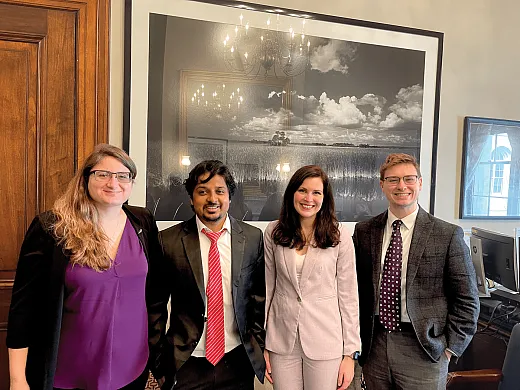
How Early Should I Apply?
This decision of when to apply can be a bit challenging. Some people recommend completing the Ph.D. preliminary exams before starting the job hunt and applications; however, some people wait until their defense date is scheduled or even do a short‐term postdoctoral position in their original lab while filling out applications for the next step. One suggestion is to collaborate with your adviser and departmental faculty to gain a thorough understanding of the timeline and application processes specific to your field and career of interest. They can certainly help with this process and make it a bit smoother. However, if you are only pursuing a master’s, you might need a full year before you plan to start your new job. Time is a crucial factor, so be mindful of it. Make sure to manage your time effectively to avoid missing out on job opportunities.
I Found an Exciting Position! How Should I Prepare?
Found a job posting that seems like the perfect fit? Wonderful first step! Here are a few ways to prepare yourself for both the application and the interview process.
The Application Package
Structuring your CV: The CV should contain contact information, professional summary, education, research experience, work experience, publications, and presentations and include skills, such as languages and technical skills in addition to awards and honors, scholarships, and recognitions. Customize your CV for each job application, emphasizing the most relevant experiences and skills. Be aware that the CV will depend on the position you are applying for—it can change between industry and academia. When possible, make sure your CV, resume, and cover letter contain some of the same language as the job post. Always ask a mentor or a friend to review your CV and ensure there are no errors.
The cover letter: The cover letter should contain an introduction mentioning the positions you are applying for and where you found the job listing. It’s important to tailor each cover letter you write to the specific position(s) you are applying for. Use this space to introduce yourself briefly. The body of the cover letter should explain why you are interested in the position and the company and highlight the most relevant experiences and skills. You can use examples from your CV. Describe how your background makes you an asset for the company and the role. Finally, add a conclusion with enthusiasm for the opportunity to interview and provide your contact information.
The Interview
Advancing to an interview with your potential employer and team members can be stressful. The following tips can help you ace your interview with confidence. Review all the details you included in your cover letter and CV as well as the position and organization. The first question you may be asked is to introduce yourself. Be prepared to briefly discuss your background and current or recent work during your graduate program. Listen carefully to the questions, and if you do not understand, ask for clarification or for the question to be repeated. Respond with concise, relevant answers. If you don’t know the answer, admit it. This honesty demonstrates straightforwardness. Research is vast, and it’s impossible to know everything, so it is perfectly acceptable to acknowledge gaps in your knowledge. Remember, a job interview is not only an opportunity for the employer to evaluate you but also for you to assess the employer, the working conditions, and the resources available.
Many companies look for answers during the interview which cover the STAR method. STAR is acronymous for S = situation—describe a specific situation or challenge; T = Task—explain the task you needed to accomplish; A = Action—detail the actions you took to address the situation; and R = Result—share the outcome or results of your actions. Common STAR interview questions:
- Tell me about a time when you overcame a significant challenge.
- Describe a project where you had to collaborate with others.
- Give an example of a goal you set and how you achieved it.
- Tell me about a time when you had to manage multiple priorities.
By thoroughly preparing your application materials and practicing for interviews, you’ll be well equipped to make a strong impression and increase your chances of securing the job.

Rejections and Learning From Job Applications
Unfortunately, job opportunities don’t always work out, and even the most shining candidates get turned down for jobs. Rejections during job applications are very common, and it’s important to try not to take them personally. Learn from each application and consider it as an important experience and practice to prepare you for the next application. Sometimes, you can politely ask for feedback on your rejections to give you insight on areas for potential improvement for your next interview. Alternatively, there may be some organizations you never hear back from. In these instances, it can be helpful to try to reach out to a hiring manager regarding the status of your application.
Society Resources for Job Positions and Preparation
For extra help in finding open positions or preparing for the job interview, check out the following resources through ASA, CSSA, and SSSA:
- Science Societies Career Center for job postings (careerplacement.org/)
- Annual Meeting programming:
- Expanding Opportunities to Diverse Career Paths
- Graduate Student Networking Session
- Life after Graduate School—Transitioning to Early Career
- Graduate student mentorship programs that can connect students to professionals in career areas of interest:
- Bridge Scholars program is available for undergraduate and graduate students and pairs them with a mentor in a related field. Applications are typically due in May.
- Greenfield Scholars program is open to students pursuing associates or bachelor’s degrees with a desire to go into the agronomy field and become a Certified Crop Adviser (CCA). Students are paired with mentors in this area, and applications are typically due in March.
- Golden Opportunity Scholars program is available to undergrads and pairs them with a mentor related to their interests. Applications are typically due in March.
Best of luck applying these skills and utilizing these resources along with the knowledge gained in graduate school to help build a rewarding career in the agronomic, crop, and soil sciences!
Connect With Us!
If you would like to give us feedback on our work or want to volunteer to join the ASA, CSSA, and SSSA(ACS) Graduate Student Committee to help plan any of our activities, please reach out to Ariana Lazo(alazo@purdue.edu), the 2024 chair of the committee!
If you would like to stay up to date with the ACS Graduate Student Committee, learn more about our work, contribute to one of our CSA News articles, or suggest activities you would like us to promote, watch your emails and connect with us on Twitter, now called X, (@ACSGradStudents), Facebook (ACS.gradstudents), or visit: agronomy.org/membership/committees/view/
ACS238/members, crops.org/membership/committees/view/ACS238/members, or soils.org/membership/committees/view/ACS238/members.
Text © . The authors. CC BY-NC-ND 4.0. Except where otherwise noted, images are subject to copyright. Any reuse without express permission from the copyright owner is prohibited.




